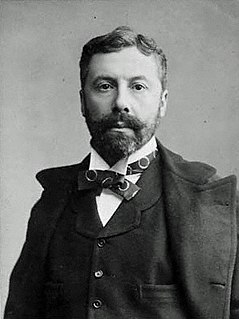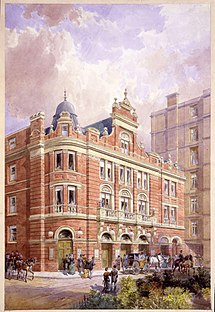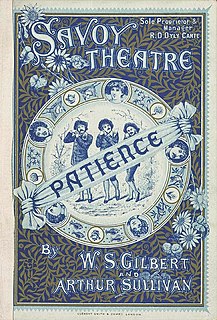Related Research Articles

Richard D'Oyly Carte was an English talent agent, theatrical impresario, composer and hotelier during the latter half of the Victorian era. He built two of London's theatres and a hotel empire, while also establishing an opera company that ran continuously for over a hundred years and a management agency representing some of the most important artists of the day.

The Savoy Theatre is a West End theatre in the Strand in the City of Westminster, London, England. The theatre opened on 10 October 1881 and was built by Richard D'Oyly Carte on the site of the old Savoy Palace as a showcase for the popular series of comic operas of Gilbert and Sullivan, which became known as the Savoy operas as a result.

The Yeomen of the Guard; or, The Merryman and His Maid, is a Savoy Opera, with music by Arthur Sullivan and libretto by W. S. Gilbert. It premiered at the Savoy Theatre on 3 October 1888 and ran for 423 performances. This was the eleventh collaboration of fourteen between Gilbert and Sullivan.

Isabel Emily Jay was an English opera singer and actress, best known for her performances in soprano roles of the Savoy Operas with the D'Oyly Carte Opera Company and in Edwardian musical comedies. During Jay's career, picture postcards were immensely popular, and Jay was photographed for over 400 different postcards.

The Gondoliers; or, The King of Barataria is a Savoy Opera, with music by Arthur Sullivan and libretto by W. S. Gilbert. It premiered at the Savoy Theatre on 7 December 1889 and ran for a very successful 554 performances, closing on 30 June 1891. This was the twelfth comic opera collaboration of fourteen between Gilbert and Sullivan.

Peter Pratt was an English actor and singer. He was best known for his comic roles in the Gilbert and Sullivan comic operas.

Patience; or, Bunthorne's Bride, is a comic opera in two acts with music by Arthur Sullivan and libretto by W. S. Gilbert. The opera is a satire on the aesthetic movement of the 1870s and '80s in England and, more broadly, on fads, superficiality, vanity, hypocrisy and pretentiousness; it also satirises romantic love, rural simplicity and military bluster.

William Martin Green, known by his stage name, Martyn Green, was an English actor and singer. He is remembered for his performances and recordings as principal comedian of the D'Oyly Carte Opera Company, in the leading patter roles of the Gilbert & Sullivan comic operas in the 1930s and 1940s, and for his career in America from the 1950s to the 1970s.

The D'Oyly Carte Opera Company is a professional British light opera company that, from the 1870s until 1982, staged Gilbert and Sullivan's Savoy operas nearly year-round in the UK and sometimes toured in Europe, North America and elsewhere. The company was revived for short seasons and tours from 1988 to 2003, and with Scottish Opera it later co-produced two productions.

Sir Henry Lytton, néHenry Alfred Jones, was an English actor and singer who was the leading exponent of the comic patter-baritone roles in Gilbert and Sullivan operas from 1909 to 1934. He also starred in musical comedies. His career with the D'Oyly Carte Opera Company spanned 50 years, and he is the only person ever knighted for achievements as a Gilbert and Sullivan performer.

Sydney Granville was an English singer and actor, best known for his performances in the Savoy Operas with the D'Oyly Carte Opera Company.

Dame Bridget D'Oyly Carte DBE was the granddaughter of the impresario Richard D'Oyly Carte and the only daughter of Rupert D'Oyly Carte. She was head of the D'Oyly Carte Opera Company from 1948 until 1982.

Rupert D'Oyly Carte was an English hotelier, theatre owner and impresario, best known as proprietor of the D'Oyly Carte Opera Company and Savoy Hotel from 1913 to 1948.

Helen Carte Boulter, also known as Helen Lenoir, was the second wife of impresario and hotelier Richard D'Oyly Carte. She is best known for her stewardship of the D'Oyly Carte Opera Company and Savoy Hotel from the end of the 19th century and into the early 20th century.

J. Ivan "Jimmy" Menzies was an English singer and actor, best known for his performances in the comic baritone roles of the Savoy Operas with the D'Oyly Carte Opera Company in Britain in the 1920s and the J. C. Williamson Gilbert & Sullivan Opera Company in Australia the 1930s and 1940s.

Harry Henry Russell, better known as Scott Russell, was an English singer, actor and theatre manager best known for his performances in the tenor roles with the D'Oyly Carte Opera Company. He was the brother-in-law of D'Oyly Carte contralto Louie René.

The Story of Gilbert and Sullivan is a 1953 British musical drama film dramatisation of the collaboration between Gilbert and Sullivan. Librettist W. S. Gilbert and composer Arthur Sullivan, portrayed by Robert Morley and Maurice Evans, co-wrote fourteen comic operas, later referred to as the Savoy Operas, which became the most popular series of musical entertainments of the Victorian era and continue to remain popular today.
Hugo Cecil Levinge Rumbold was an English designer of theatrical scenery and costumes. Among those who commissioned designs from him were Sir Herbert Tree, Sir Thomas Beecham, Arthur Bourchier and Rupert D'Oyly Carte.

Gilbert and Sullivan for All was a touring concert and opera company, formed in 1963 by D'Oyly Carte Opera Company performers Thomas Round and Donald Adams and former director Norman Meadmore, and which exclusively performed the works of Gilbert and Sullivan, usually in concert, but sometimes giving full productions. They also recorded most of the Savoy operas both on video and audio. They continued to tour into the 1980s, occasionally reuniting for performances thereafter.

The Mikado is a 1967 British musical film adaptation of Gilbert and Sullivan's 1885 comic opera of the same name. The film was directed by Stuart Burge and was a slightly edited adaptation of the D'Oyly Carte Opera Company's production of The Mikado and used all D'Oyly Carte singers.
References
- The Savoyard, obituary notice, September 1974.
- Books by Goffin